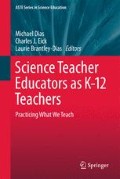Abstract
In order to more effectively prepare future science teachers and more adequately provide professional development for existing teachers, Kimberly Lott has always viewed research through a “teacher lens.” This lens was fine-tuned by her previous experiences as a middle and high school science teacher and the commitment to remain active in local schools. When her appointment changed from secondary to elementary science, Dr. Lott realized that her “teacher lens” was out of focus, and she needed experience in elementary classrooms. This chapter describes Kim’s experiences working with the teachers at the Edith Bowen Laboratory School on the campus of Utah State University. Dr. Lott describes how she revised her approach to reflect the original intent of the laboratory school as a place to apply research to practice and how experiences teaching children have focused her vision as a science teacher educator.
Access this chapter
Tax calculation will be finalised at checkout
Purchases are for personal use only
Notes
- 1.
EBLS demographics: 12 % special education, 31 % free and reduced lunch, 20 % minority.
References
Bonar, B. D. (1992). The role of laboratory schools in American education. National Association of Laboratory Schools Journal, 17(1), 42–53.
Cassidy, J., & Sanders, J. (2002). A university lab school for the 21st century development center. EarlycChildhood literacy: Programs & strategies to develop cultural, linguistic, scientific and healthcare literacy for young children and their families, 2001 yearbook. Corpus Christi: Center for Educational Development and Evaluation, Texas A&M University. (ERIC Document Reproduction Service No. ED 468 858).
Cronin-Jones, L. L. (1991). Science teacher beliefs and their influence on curriculum implementation: Two case studies. Journal of Research in Science Teaching, 28, 235–250.
Edith Bowen Laboratory School (EBLS). (2012). Retrieved March 13, 2012, from http://edithbowen.usu.edu/htm/about
Flick, L.B. (1997, March). Focusing research on teaching practices in support of inquiry. Paper presented at the annual meeting for the National Association of Research in Science Teaching, Chicago.
Jackson, C. L. (1986). Status of laboratory schools. Jacksonville: Florida Institute of Education. (ERIC Document Reproduction Service No. ED 277 691).
Johnson, W. F. (2006). The laboratory school: Yesterday, today and tomorrow. (Doctoral dissertation). Retrieved from ProQuest Dissertation and Theses. (AAT 3232513).
Lott, K. H. (2011). FIRE UP the Inquiry. Lose the routine, tweak your “cookbook lab”, and reach a level of open inquiry with these strategies used during a unit on heat. Science and Children, 48(7), 29–33.
Lott, K. H., & Jensen, A. (2012). Changes matter! Addressing misconceptions students have about physical and chemical changes. Science and Children, 50, 54–61.
Lott, K. H., & Read, S. (2012). “Is a mealworm really a worm?” Introducing science notebooks to novice writers. Science and Children, 49(5), 32–37.
Lott, K. H., & Wallin, L. (2012). Modeling the states of matter in a first-grade classroom. Science Activities, 49, 108–116.
Olson, J. (1981). Teacher influence in the classroom: A context for understanding curriculum translation. Instructional Science, 10, 259–275.
Rivard, L., & Straw, S. (2000). The effect of talk and writing on learning science: An exploratory study. Science Education, 84(5), 566–593.
Tanner, L. (1997). Dewey’s laboratory school: Lessons for today. New York: Teacher College Press.
Vosniadou, C., & Ioannides, C. (1998). From conceptual development to science education: A psychological point of view. International Journal of Science Education, 20, 1213–1230.
Author information
Authors and Affiliations
Corresponding author
Editor information
Editors and Affiliations
Rights and permissions
Copyright information
© 2014 Springer Science+Business Media B.V.
About this chapter
Cite this chapter
Lott, K. (2014). Reestablishing the Role of the University Professor in the Laboratory School: Retooling in an Elementary Classroom. In: Dias, M., Eick, C., Brantley-Dias, L. (eds) Science Teacher Educators as K-12 Teachers. ASTE Series in Science Education, vol 1. Springer, Dordrecht. https://doi.org/10.1007/978-94-007-6763-8_17
Download citation
DOI: https://doi.org/10.1007/978-94-007-6763-8_17
Published:
Publisher Name: Springer, Dordrecht
Print ISBN: 978-94-007-6762-1
Online ISBN: 978-94-007-6763-8
eBook Packages: Humanities, Social Sciences and LawEducation (R0)

